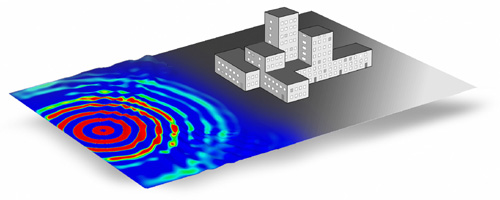Structural Dynamics and Wave Propagation
Densification of cities and more efficient use of land has led to that residential buildings are today built closer to roads and railroads, which means there is an increased risk of noise and vibrations in living environments. It is well known that these disturbances cause health issues. Material-efficient construction, including re-use of components, which is desirable from a sustainability perspective, also implies an increased risk of problems related to noise and vibrations. These are examples on why development of analysis methodology and structural design concepts within the area is of great importance.
Our work on structural dynamics and wave propagation is driven by the desire to understand physical phenomena and the need to develop engineering solutions to vibration problems affecting stakeholders in, primarily, the built environment, but also within the vehicle industry. The research problems we address often require a synthesis of experimental testing, model development, including reduced-order modeling techniques, and computational simulations.
Structural Dynamics
In structural dynamics applications we work on both developing computational models and innovative solutions to mitigate vibrations and noise. Applications include wooden buildings which are afflicted with some drawbacks in terms of vibro-acoustic performance, such as step-sound isolation, as compared to traditional concrete buildings. Here, we work on both developing computational models for investigating the underlying physics and development of mitigation measures.
If a glass barrier constitutes a safety risk for building occupants, building regulations in most countries prescribe that the glazing must be designed to withstand accidental impact of humans. A dynamic verification is then required, usually performed by experimental testing. The aim of our work is to develop accurate and efficient computational models for prediction of the dynamic pre-failure elastic response.
Ground Vibrations
Ground vibrations, induced by, for example, train traffic, can excite buildings so that residents will be annoyed, or sensitive equipment can malfunction. Here we have developed computational models which allow rapid simulations of such vibrations in buildings, for decision-making in industrial projects. We are especially focused on timber buildings because of the lack of empirical data in this area. The models include the description of the trainload, rail unevenness, embankment, soil, foundation, soil-structure interaction as well as the building.
Fluid–Structure Interaction
This topic relates to the studies of how a structure's vibrations interact with surrounding fluids. Engineering applications that we work with include acoustic response in timber buildings, cabin noise in cars, and noise transmission in water-pipe systems.

